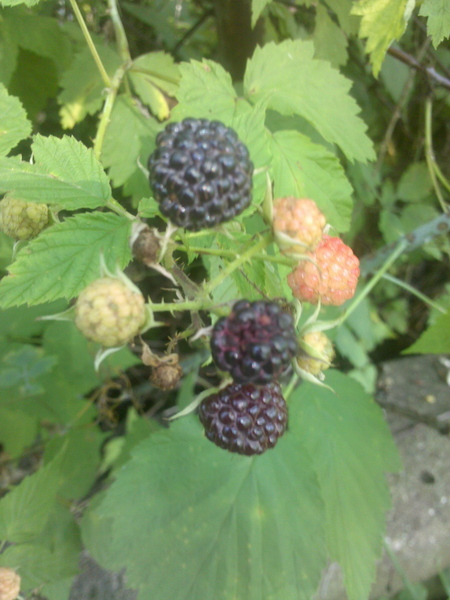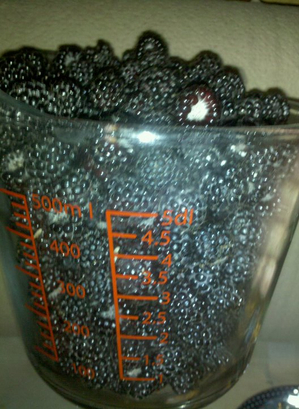Wildcrafting: Black raspberry: Where to find this favorite fruit of foragers in Ann Arbor

Black raspberries ready to be enjoyed.
Linda Diane Feldt | Contributor
We are in the midst of peak black raspberry (BRB) season in lower Michigan. There are dozens of prime places to pick in Ann Arbor. The recent rains have helped create juicy berries, and the abundant warmth and sunshine have caused vines to be heavy with ripe fruit just waiting to be enjoyed.
I’ll give you a few hints on where to find these jewels without leaving the city, as well as a couple of ideas on how to enjoy them other than feasting as you pick.
Kids who spend time in the woods, outdoors, on the outskirts of playgrounds and fields, soon learn all they need to know about black raspberries. The brambles and bumpy fruit are unique, making identification easy. While many of the smooth colored berries will make you sick, raspberries in their many forms and colors are a treat and it's even easy to tell the ripe ones from the unripe - if the caps pull away easily from the green bottom you have it.
Ideally, finding and eating ripe raspberries would be part of every kid’s childhood.
The reality is that this is one more abundant food that most will walk by without seeing, and certainly there are too many adults who don’t take the time, who forget to get out, who finally decide to look for these luscious berries, only to discover that either the season is past or the vines have been already stripped clean.
It is a short wonderful season. Don’t put off visiting a nearby patch.
Raspberries don’t really need recipes to enjoy, but I can list a few ways to use them that may be new to you. Of course, spending breakfast in the backyard or nearby field just picking and eating may be the best idea by far. Bring some home to eat with oatmeal or other cereal. Added to yogurt, perhaps accompanied by some chopped almonds or walnuts, you have great texture and taste.
My foraging friend makes a black raspberry wine that is beautiful, full tasting, warm, with just enough sweet to balance the alcohol. The aftertaste is just perfect for wanting that next sip. A simple juice made from the berries can be enjoyed as is, or carbonated for a more nuanced flavor. Fruit leather is another possibility, as well as pies, smoothies, cobbler, and as an addition to cornbread. Jams and jellies are great ways to showcase and preserve black raspberries. I'm lucky to have a lot of friends who choose this method; every year I am gifted with enough jars that I've never had to make my own.

Picked in about 20 minutes, these black raspberries are headed for the freezer.
Linda Diane Feldt | Contributor
My favorite is to stock my freezer and enjoy them in oatmeal all winter long. Not only do they taste great added right at the end of cooking, but also they turn the oatmeal a fabulous deep vibrant purple color. I always write on the bag where they were picked as well as when. In winter, I appreciate that bit of memory of a warm summer day standing in the green prickly patch, with stained fingers and happy tastebuds.
The mosquitoes are the main problem when picking. Morning is a good time to avoid heat and bugs. And where can you go? My best advice for in-town picking is any of the schoolyards. Classes are out, and the school system doesn’t spray. Look around the edges and fences of the schools - most of them have patches that aren’t being picked. Many of our parks have great raspberry patches as well, but the ones near the paths tend to be well-known and frequently visited.
The red raspberries are also just coming into perfection. Less common, their vines are less overwhelming and more restrained. So far the red raspberries I’ve found this season are exclaim-out-loud great: sweet and bursting with raspberry flavor. They're well worth getting off the beaten path to find.
Linda Diane Feldt is a local Holistic Health Practitioner, teacher, and writer. You can follow her on twitter, visit her web site, or contact her ldfeldt(at)holisticwisdom.org Linda Diane teaches a free monthly class on herbal wisdom sponsored by The People’s Food Co-op.


Comments
E. Daniel Ayres
Mon, Jul 5, 2010 : 3:17 p.m.
I'm thinking of offering a "class" at the Growing Hope center in Ypsilanti. It will cover the annual "tricks of the trade" process for wild black raspberry permaculture I've developed over a lifetime. We have a thriving wild "patch" in our "Urban Forest" area on the site which was well picked this season. I envision meeting once in the fall, once in the early spring, once a week or two before harvest begins, during harvest, and post harvest for a "wrap up" session. Note: I wash my pickings, spread them on paper towels laid on a cookie sheet to dry, freeze them on the sheet, then pack the frozen berries into freezer containers for permanent storage. My favorite use of these frozen berries is "black raspberry corn-cake-cake" made off season with Jiffy Corn Muffin mix, bacon grease from a batch of bacon, and a cup of frozen berries from the freezer. In season, sleeping oudoors, cooking over an open fire, use an old cast iron skillet to make bacon and eggs, and then a batch of corn-cake-cake with fresh berries picked before you start breakfast.
JanL
Sun, Jul 4, 2010 : 5:14 p.m.
At the risk of leading anyone astray, I post this link to a recipe for Black Raspberry Daiquiris, which our neighbor down the street introduced us to a couple summers back. We love to eat the black raspberries we grow in our garden for snacks and in pies to such an extent that we were initially hesitant to risk "wasting" berries for daiquiris, but in the realm of adult beverages, these are something special and worth trying.
Linda Diane Feldt
Wed, Jun 30, 2010 : 6:23 p.m.
While some have elaborate instructions for freezing berries, I just put them in a freezer bag or tofu tub and stash them in the freezer. In my chest freezer they are fine for more than a year. If you lay the bag flat, it is easier to break off chunks of them. Some people freeze on cookies sheets first, then put into bags, but i don't have the room or the patience to do that. If you want to rinse them first, try and get them as dry as possible before freezing, and then do use either the very flat bag or cookie sheet method. Otherwise they will freeze into one lump. Be sure and label the bag with permanent marker - type of berry, date and location where they were picked.
Jeannette Gutierrez
Wed, Jun 30, 2010 : 5:06 p.m.
Any special instructions or tips on how to freeze? Just throw them in a bag, then in the freezer?
JJM
Wed, Jun 30, 2010 : 7:46 a.m.
I'm pretty sure the spray signs in the Arb had to do with invasive plants along the paths of Dow Prairie. It's my impression that they do a pretty good job of spot painting or spraying (I've watched them in the past). I'm glad you mentioned the poison ivy. As a long-time dog walker in the Arb and other wooded parks (e.g., Marshall Park), I'm noticing that the poison ivy has been spreading rapidly in recent years. It seems to be everywhere I look now, whereas a few years ago, there seemed to be only limited patches. By the way, dogs love freshly picked raspberries. Our two Labs sit patiently waiting for their share whenever we pick. Of course, Labs will eat almost anything, but they really seem to love the raspberries.
Linda Diane Feldt
Wed, Jun 30, 2010 : 7:37 a.m.
There are indeed many additional warnings that can be given with, with any harvesting. I try to repeat them periodically. Some are obvious, but a friend thought I should have mentioned thorns. Serious pickers do tend to carry a few scratches home as well. Poison ivy is another. Combined with mosquitoes, those three things make long pants and shirt with sleeves practical for picking. I say it again and again but never too often - never pick under high tension wires and near rail road tracks. They spray, don't post it, and you never know when it will be done. And the spraying is often mechanical and wide. The city parks do a great job for the most part of spot spraying, and using great signage. The UM has its own rules and ideas about what to do to maintain their grounds. I'm glad you were noticing what the mom did not. That's the extent of the dangers I can think up this morning. Any more I'm forgetting or think are so obvious I forget about it but should be included?
Rork Kuick
Wed, Jun 30, 2010 : 7:23 a.m.
I treat Arb as a "take nothing" zone, and that includes black morels (the agony!), and it may be posted as such.
aa-mom
Wed, Jun 30, 2010 : 7:11 a.m.
There are quite a few wild black berry plants in the prairie section of the Arb. I found a mom and her young child picking and eating them yesterday. BUT, right next to the plants was a small..very small sign that pesticides had been sprayed in the area. No date on the signs or what the pesticides were or for!! The mom was very upset when I pointed this out as it was not known whether whatever was sprayed was harmful or still around. Please, Arb officials, better signage!!!!
Linda Diane Feldt
Tue, Jun 29, 2010 : 7:56 a.m.
Rork, I hope that we have to worry about competition. Both Ed Vielmetti and I gave away the locations for service berries, downtown, easily available, and it made no difference. Most of the berries withered on the trees. Untouched by humans or birds. My thinking is that there really are plenty to go around, and competition is good if it means more people get outside enjoying nature. And, I do apologize if that seems presumptuous and costs you some berries. And also if I'm taking your comment too seriously! Now morel locations, shown in your photo, I promise to never reveal. There is a whole unwritten code and ethics about that. Although I have given the generic guidance to check old apple orchards.
Rork Kuick
Tue, Jun 29, 2010 : 7:17 a.m.
Doh, you aren't supposed to tell people! I've got enough competition.